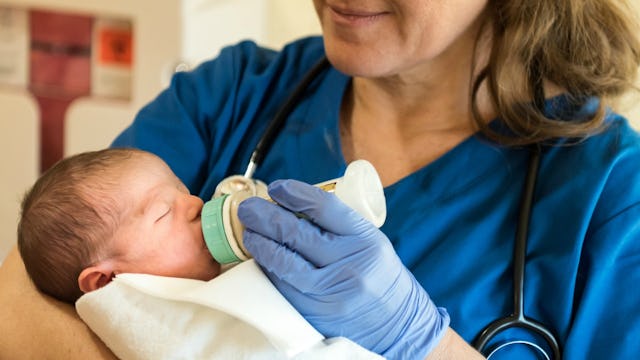Everyone Passes Through the Hands of a Nurse

As I stepped onto the hospital unit, I immediately felt my heart begin to race and my palms start to sweat.
I was a third year nursing student reporting to a busy cardiac intensive care unit in a big city children’s hospital for my summer job as a nurse extern. Though I’d spent several years learning nursing basics and committing nursing theory to memory, nothing prepared me for the sights and sounds of an ICU dedicated to children with heart defects.
“Well, are you ready?” the nurse I’d be working with said as my eyes filled with panic. “Come on, let me show you what you’ll be doing.”
She guided me into a private room, with a small baby lying on a tall crib, hooked up to monitors and IV drips. As we stood over the crib, she smiled and said my duties would be limited to changing bed linens, stocking rooms with necessary supplies like diapers and wipes and sitting with babies when their parents couldn’t be at their bedside.
In short, the majority of my job was to hold babies and use the healing touch of my hands to make them more comfortable. And, though I was inexperienced as a nurse, hugging a baby and using various forms of touch therapy seemed simple enough yet provided had the power to change outcomes.
Over the course of that summer, I learned how to incorporate skills like facilitated tucking — a technique that involves holding an infant’s arms and legs flexed close to the body in an effort to reduce pain during procedures — into my daily routine with the babies on the unit.
I learned how to perform skin-to-skin care, also commonly referred to as Kangaroo Care, on my little patients. I’d sit with a baby, clad only in a Huggies diaper specifically designed for their needs, with their skin touching mine as we rocked in a chair next to their intensive care crib. Though there are over 600 scientific papers published on the effects of touch therapy on babies, the sigh of a small infant releasing tension at the feel of my touch was evidence enough for me.
According to a recent Huggies study titled “The Power of Human Touch for Babies,“ hugs can do more than calm a cry or soothe stress. Skin-to-skin contact can help keep a baby’s heart beating at a normal rate, improve sleep and support healthy weight gain. MRI and PET scans have also revealed that hugs stimulate the release of dopamine, the body’s natural feel-good chemical.
And, when a baby covered in leads, wires, tubes and monitoring devices relaxed into my chest, I can say with authority that I’ve seen firsthand how simply holding a baby makes a difference. There’s nothing like it, honestly, and being able to spend a summer honing the simple craft of touch therapy proved to be invaluable across my nursing career, and an experience I’ve never forgotten.
My nursing school’s motto was “Everyone passes through the hands of a nurse” and our class had t-shirts made with the motto emblazoned across the back as a fundraiser. Throughout the years I’ve proudly worn the shirt and every time I do, I catch myself thinking about the power of hugs and small gestures in making a patient’s journey more bearable.
Nurses use their hands to help a mother guide a new baby into the world.
Nurses use their hands to hold that of one who is passing from this earth.
Nurses use their hands to wipe the tears of a child who has skinned his knee on the playground.
And, nurses use their hands to bathe those who can no longer do so for themselves.
With their tiniest patients, nurses use their gentle touch to lull a fussy toddler to sleep or to tickle the cheek of a baby who is learning to smile in an ICU bed. Often, their touch is a substitute for the parents who, because of work responsibilities and financial burdens, cannot be with their child during a trying medical situation. Nurses, in the most simplistic way, use their hands to bring healing and kindness to the darkest of moments.
Everyone passes through the hands of a nurse, it’s true.
And thank goodness.
You can give hugs to these babies, too by becoming a Huggies member. When you sign up at Huggies.com/NoBabyUnhugged. Huggies will donate $5 to help ensure the tiniest babies get the hugs they need. Through the Huggies No Baby Unhugged program the brand is awarding $10,000 grants to 25 eligible hospitals throughout 2017, enabling them to launch a new hugging program or expand support for an existing program in their hospitals.
Huggies – the fastest growing diaper brand in U.S. hospitals – believes deeply in the Power of Hugs, which is why every diaper and wipe is inspired by a parent’s embrace. The Huggies No Baby Unhugged program helps ensure all babies get the hugs they need to thrive by supporting hugging programs in hospitals and donating diapers across the country. Learn how you can help at Huggies.com.
This article was originally published on